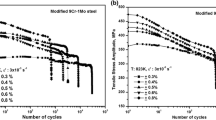Abstract
High strength-low alloy (HSLA) steels are a relatively new group of alloys similar to hot rolled low carbon steel (HRLC) but having higher strengths as a result of composition and processing variations. Because these steels are of potential use in a variety of structural applications involving cyclic loading a knowledge of their fatigue behavior is important. Fatigue experiments were performed on several 80 ksi yield strength HSLA steels and on conventional HRLC steel for comparison. The HSLA steels were all found to exhibit similar fatigue resistance, and were superior to HRLC steel at longer lives. The effects on fatigue behavior of two types of plastic prestrain were determined. While prestrains caused large increases in monotonic strength properties, such improvements were largely lost in fatigue due to cyclic softening. Tensile prestrains are more detrimental to fatigue resistance than compressive prestrains. Finally, it was found that HSLA steel has a higher fatigue notch sensitivity than HRLC steel, however its notch fatigue resistance is still superior to that of HRLC steel.
Similar content being viewed by others
References
J. A. Vaccari:Mater. Eng., 1974, vol. 79, no. 2, pp. 24–28.
E. R. Morgan, T. E. Danay, and M. Korchynsky:Metal Progr., 1966, vol. 89, no. 1, p. 125.
M. Korchynsky and H. Start:Symposium Low Alloy High Strength Steels, p. 17, The Metallurg Companies, New York, 1970.
J. M. Gray:Processing and Properties of Low Carbon Steel, J. M. Gray, ed., p. 225, TMS-AIME, New York, 1973.
L. Meyer, F. Heisterkamp, and D. Lautenborn:Processing and Properties of Low Carbon Steel, J. M. Gray, ed., p. 297, TMS-AIME, New York, 1973.
L. Luyckx, J. R. Bell, A. McLean, and M. Korchynsky:Met. Trans., 1970, vol. 1, pp. 3341–50.
J. M. Gray:Cold-Rolled High-Strength Steels for Automotive Applications, SAE paper no. 730527.
C. E. Feltner and M. R. Mitchell:Manual on Low Cycle Fatigue Testing, ASTM STP 465, p. 27, American Society for Testing and Materials, Philadelphia, 1969.
D. T. Roske and JoDean Morrow:Manual on Low Cycle Fatigue Testing, ASTM STP 465, p. 1, American Society for Testing and Materials, Philadelphia, 1969.
T. H. Topper, R. M. Wetzel, and JoDean Morrow:J. Mater., JMLSA, March 1969, vol. 4, no. 1, p. 200–09.
H. Neuber:J. of Appl. Mech, 1961, vol. 28, pp. 544–50.
C. E. Feltner and P. Beardmore:Achievement of High Fatigue Resistance in Metals and Alloys, ASTM STP 467, p. 77, American Society for Testing and Materials, Philadelphia, 1970.
JoDean Morrow:Internal Friction, Damping, and Cyclic Plasticity, ASTM STP 378, p. 45, American Society for Testing and Materials, Philadelphia, 1965.
Author information
Authors and Affiliations
Rights and permissions
About this article
Cite this article
Sherman, A.M. Fatigue properties of high strength-low alloy steels. Metall Trans A 6, 1035–1040 (1975). https://doi.org/10.1007/BF02661357
Received:
Issue Date:
DOI: https://doi.org/10.1007/BF02661357




